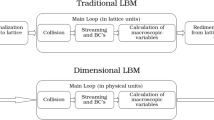Abstract
A numerical algorithm is proposed for solution of the transient heat-conduction equation by the Monte Carlo method. The calculated values of the temperature are compared with experimental data.
Similar content being viewed by others
Abbreviations
- U:
-
temperature
- t:
-
time
- a :
-
thermal diffusivity
- x, y, z:
-
coordinates
- (x, y, z, t):
-
temperature on the surface of the body
- g(x, y, z):
-
initial temperature
- T:
-
finite time of investigation of the process
- ′ϕ (x, y, z, t) = F (x, y, z, t)/cρ:
-
where F(x, y, z, t) is an internal heat source
- c:
-
specific heat
- ρ:
-
density
Literature cited
S. M. Ermakov and G. A. Mikhailov, Course in Statistical Modeling [in Russian], Nauka, Moscow (1976).
V. S. Gladkii, Probabilistic Computational Models [in Russian], Nauka, Moscow (1973).
N. P. Buslenko and Yu. A. Shreider, The Monte Carlo Method [in Russian], Fizmatgiz, Moscow (1961).
Hardening of Metals, Proc. Second Conf. Theory of Casting Processes [in Russian], Mashgiz, Moscow (1958).
Additional information
Translated from Inzhenerno-Fizicheskii Zhurnal, Vol. 39, No. 4, pp. 745–747, October, 1980.
Rights and permissions
About this article
Cite this article
Vorob'eva, L.S., Zhevlakov, G.N. Mathematical modeling of a transient heat-conduction process. Journal of Engineering Physics 39, 1155–1157 (1980). https://doi.org/10.1007/BF00822156
Received:
Issue Date:
DOI: https://doi.org/10.1007/BF00822156




